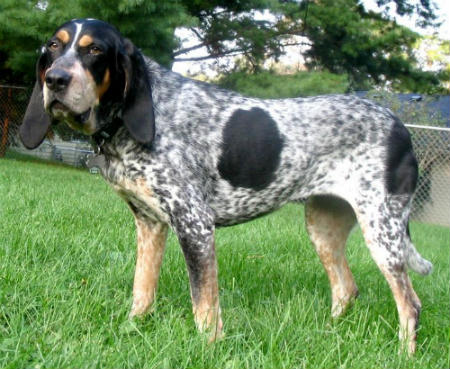If you thought you had known all the existing dog breeds, and the surprising characteristics of each of them, you are wrong. There is still much to explore on this topic, details of breeds that will surprise you, as is the case of the peculiar
Great Blue of Gascogne . Named in this way because of its bluish coat, which gives great particularity to the large and robust appearance that distinguishes the presence of this breed. The Great Blue of Gascogne is native to France, with great popularity in hunting activities, an animal descended from hounds. This canine has had great recognition by society for its imposing figure and agility. Although it is a dog with a friendly temperament, it is not the common type of pet for any home, as it has individual aspects that make it more suitable for life in the countryside. An owner who knows about the treatment and handling of these animals is the most appropriate, for this reason, we have prepared an article with all the details you should know about these dogs and you can discover if their skills, care, behavior and appearance, are They adapt to the pet you need for you.
Origin of the Great Blue of Gascogne
Although there is no precise date related to the appearance of this breed, it is recognized that
its native country is France , more specifically
Gascony (Gascogne) , where these dogs were the result of different crosses. What is indisputable is that the breed is one of the oldest in the canine world, its beginnings are related to
the Saint Hubert Dog , which was crossed with other hounds, resulting in the Great Blue of Gascogne. It is presumed that the ancestors of this dog were hounds brought to French lands by Phoenician and Roman traders,
destined mainly for hunting , an activity with which the breed was and still is recognized.
Although its existence was considerably threatened with the arrival of the French Revolution, its ability to hunt small animals made breeders interested in it as a companion in this activity. Later he gained popularity and moved to the United States, where he became more recognized than in his country of origin. There it is used the same, for hunting activities, but for larger animals such as deer and wild boar. In other countries such as Spain, it is used as a companion dog in some cases, however, these animals require a knowledgeable owner to maintain them.
Appearance of the specimens
A typical example of a hunting pack, this breed is characterized not only by its large and distinguished size, but also by its pronounced bones, which give it an imposing and prominent presence. Let's look at the most distinctive characteristics of this canid.
Size and weight of the Great Blue of Gascogne
Regardless of the sex of these canines, their size averages between 60 and up to 72 centimeters in height. Accompanied by a weight that approximates 40 and up to 59 kilograms, its muscular body demonstrates the strength and agility that this species possesses.
Head
These hounds have a slightly elongated head, not very pronounced, but quite strong. Their ears are stretched, set low from eye level and hanging. It has a medium nose and medium eyes, rounded and generally dark in color. It also has a notably elongated neck and body.
Extremities
Like the rest of its body, the Great Gascogne Blue's limbs are formidable. The front legs are thick and straight, giving security when stepping, while the solidity of its hind legs gives it agility in movement and stability.
Line
A thickened, long tail, with slight curves in its path and set low, is what accompanies the robust and profiled body of this breed.
Fur
If there is a characteristic aspect of these canines that should be highlighted without a doubt, it is the coat. Although it is an evidently short, thin and quite dense coat, with a rough appearance to the touch, what is peculiar is its bluish appearance, which gives it great particularity. The abundant black and white specks on its body are what give it the blue appearance that covers its skin. Two tan marks are evident in the eyebrow area, and on a large part of the face, specifically in his eyes, there are two well-pronounced black spots that give him an image of mystery and seriousness at the same time.
Character of the Great Blue of Gascogne
The character of this breed is quite pleasant. They are really obedient, attentive and above all very active, due to the natural ability to hunt, this has also allowed them innate socialization, due to having to be part of a pack. However, strengthening this topic is very important in training. It is an obedient,
docile and kind animal that it considers its family . It loves to do outdoor activities and requires a lot of exercise, because otherwise it will become a hyperactive and even destructive animal. They are not very fond of urban life, because their preferred habitat is the countryside, where they can move freely. In addition, it is an animal with a tendency to bark frequently and very loudly, which can bother neighbors in a building, for example. This peculiarity also makes it an excellent watchdog as it always remains alert and will not hesitate to warn if it observes any abnormality. However, these dogs should not be allowed to sleep outdoors, because if they are not well trained, they can run after prey and get lost. Regarding coexistence with other animals, adaptation may not be a problem, since
they are accustomed to the presence of other dogs due to belonging to packs in their hunting activities. He tends to be a little distrustful with other people, but it will take a few hours for him to feel at ease, once he identifies him as a family acquaintance. Although they are independent and large in size, it is not advisable to leave them alone for a large amount of time, as they can begin to cause destruction within the home, as a way of unleashing their accumulated energy. They must have the time necessary to provide long walks and appropriate exercise routines so that they remain emotionally and physically balanced. Although they have a fairly calm temperament, these dogs require an owner who is knowledgeable about their behavior, the care they require and how to educate them correctly.
Training
Although the Great Blue of Gascogne is a docile, obedient and attentive animal, it is necessary
to carry out rigorous and adequate training with this breed , otherwise, it will not be the ideal dog to be chosen as a pet. Mainly, it must be taken into account that this is a pack dog with a tendency to react to the presence of smaller animals, starting a chase. It is for this reason that knowing about the bases of their training is widely necessary. The education of this big guy must begin from his first weeks of life, with the socialization process as the first lesson. Once the basic aspects of this topic have been practiced, more advanced lessons can be included, such as behavior inside and outside the home, living with the family, also alternating with walks where they can be in contact with their environment and other animals. After having advanced on these topics, it is necessary to reiterate them consecutively, this will ensure that the dog is domesticated correctly. The Great Blue of Gascogne is a pack animal and to a certain extent independent, which enjoys large size and imposing presence, for this reason, it is necessary to educate it considering positive reinforcement as a technique. Commands should be given calmly and avoiding abuse or shouting, otherwise the dog could adopt aggressive behavior. Motivation and reward are excellent allies in the education of this hound.
Health of the Great Blue of Gascogne
The Great Blue Gascogne Hound has generally become famous for its good health. Thanks to this, he has such a muscular and energetic body. This breed has a life expectancy that can reach up to twelve years, without suffering from breed-specific diseases. However,
obesity is one of the risk factors most associated with these dogs , because if it is not fed correctly and does not get enough exercise, it can be directly affected. On the other hand, the elongated and fallen shape of its ears makes it prone to the accumulation of bacteria and fungi in this area. This makes it necessary to maintain vigilance and particular care in the hygiene of your ears, thus avoiding the appearance of these illnesses. With the exception of the conditions mentioned, this dog enjoys good health, which will also largely depend on the care and attention given to it by its family members.
Care required by this breed
It is worth noting that this breed of rustic dogs, accustomed to country life, does not require excessive effort to care for. It will be enough to maintain some conditions in its care to ensure that it grows with proper well-being and a good quality of life. Below we will present the
most essential care that the Great Blue of Gascogne requires :
Exercises
If there is something that cannot be missed with the Great Blue of Gascogne, it is the practice of daily exercises. These dogs should be allowed to run, carry out hunting activities, and move freely for at least 3 hours a day, otherwise they could adopt negative behaviors.
Feeding
Because they are breeds with a tendency to obesity,
it is important to combine exercise with adequate nutrition , also remembering not to overfeed and to provide the necessary nutrients to strengthen their bone system.
Cleanliness
The Great Gascogne Blue is an animal with short fur, so brushing is not as demanding as other breeds; at least once a week will be enough to maintain the natural shine of its fur. As for bathing, it can be done monthly or when the dog is really dirty.
Ear and paw hygiene
When grooming the Great Blue of Gascogne, we must not forget at any time to
clean and constantly supervise its ears , because due to their position and length, great humidity can accumulate and cause the appearance of fungi and bacteria. Likewise, periodically checking the pads of their paws is of great importance, especially after a walk, because they can be punctured by some object and cause unwanted injuries.
Medical checks
Finally, carrying out periodic checkups with the veterinarian, as well as correct vaccination and deworming, will help you maintain your optimal state of health.
Conclusion
Without a doubt, a strong, healthy and very active animal is what characterizes the Great Blue Gascogne Hound. A preferred animal for activities such as hunting and living in the countryside, where it will enjoy working with the family and being outdoors most of the time. It also has a unique tone of voice, usually very noisy, which does not make it an animal suitable for urban life. However, with proper socialization and time commitment
, these dogs make excellent pets . Dedicating time and knowledge to its education will give excellent results, but it is necessary for its owner to have knowledge about the dog in order to guide it correctly, maintaining consistency and motivation during training. Learn more about dogs:













